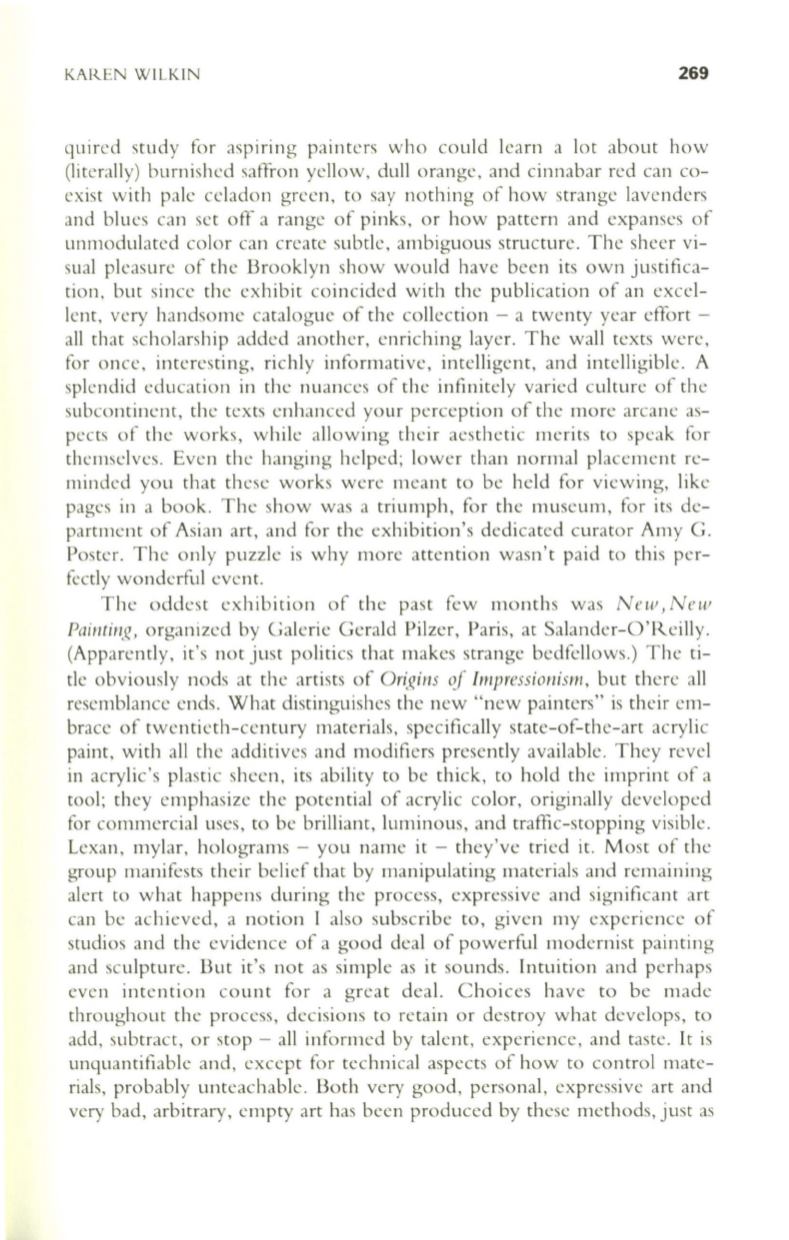
KAR.EN WILKIN
269
quired study for aspiring painters who could learn a lot about how
(literally) burnished saffron yellow, dull orange, and cinnabar red can co–
exist with pale celadon green, to say nothing of how strange lavenders
and blues can set off a range of pinks, or how pattern and expanses of
unmodulated color can create subtle, ambiguous structure. The sheer vi–
sual pleasure of the Brooklyn show would have been its own justifica–
tion, but since the exhibit coincided with the publication of an excel–
lent, very handsome catalogue of the collection - a twenty year effort -
all that scholarship added another, enriching layer. The wall texts were,
for once, interesting, richly informative, intelligent, and intelligible. A
splendid education in the nuances of the infinitely varied culture of the
subcontinent, the texts enhanced your perception of the more arcane as–
pects of the works, while allowing their aesthetic merits to speak for
themselves. Even the hanging helped; lower than normal placement re–
minded you that these works were meant to be held for viewing, like
pages in a book. The show was a triumph, for the museum, for its de–
partment of Asian art, and for the exhibition's dedicated curator Amy G.
Poster. The only puzzle is why more attention wasn't paid to this per–
fectly wonderful event.
The oddest exhibition of the past few months was
New, New
Pai"tinJ?,
organized by Galerie Gerald Pilzer, Paris, at Salander-O'Reilly.
(Apparently, it's not just politics that makes strange bedfellows.) The ti–
tle obviously nods at the artists of
Origins oj Impressiortism,
but there all
resemblance ends. What distinguishes the new "new painters" is their em–
brace of twentieth-century materials, specifically state-of-the-art acrylic
paint, with all the additives and modifiers presently available. They revel
in acrylic's plastic sheen, its ability to be thick, to hold the imprint of a
tool; they emphasize the potential of acrylic color, originally developed
for commercial uses, to be brilliant, luminous, and traffic-stopping visible.
Lexan, mylar, holograms - you name it - they've tried it. Most of the
group manifests their belief that by manipulating materials and remaining
alert to what happens during the process, expressive and significant art
can be achieved, a notion I also subscribe to, given my experience of
studios and the evidence of a good deal of powerful modernist painting
and sculpture. But it's not as simple as it sounds. Intuition and perhaps
even intention count for a great deal. Choices have to be made
throughout the process, decisions to retain or destroy what develops, to
add, subtract, or stop - all informed by talent, experience, and taste.
It
is
unquantifiable and, except for technical aspects of how to control mate–
rials, probably unteachable. Both very good, personal, expressive art and
very bad, arbitrary, empty art has been produced by these methods, just as


